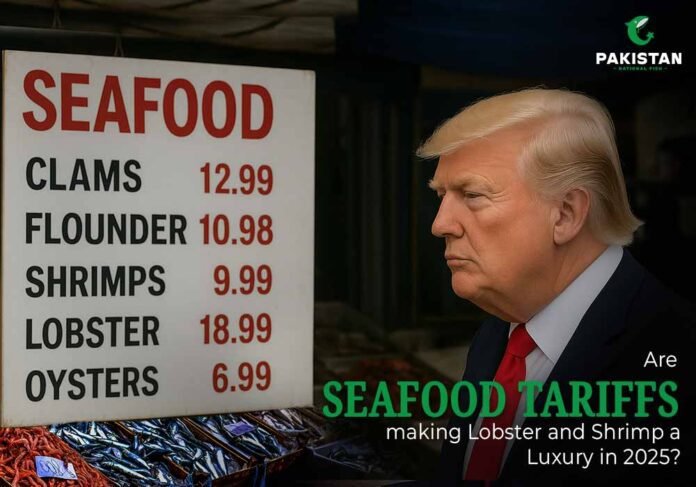Seafood has always felt like a little luxury, whether it’s a buttery lobster roll on the coast of Maine, shrimp sizzling on the grill at a backyard cookout, or salmon on a weeknight dinner table. But in 2025, with seafood tariffs driving prices higher, that “luxury” is hitting wallets harder than ever.
If you’ve been to the seafood counter lately, you’ve probably noticed the sting. Prices are climbing across the board, and not just by a little. What’s going on? Put simply, a mix of tariffs, climate stress, and inflation are reshaping the seafood market, and shoppers are feeling it every time they check a menu or fill a basket.
Let’s break down what’s happening and, more importantly, how you can still enjoy seafood without overspending.
The Snapshot: Seafood In 2025
Here are a few quick tidbits that tell the story:
- Shrimp imports rose 18% early this year, but tariffs may slam the brakes on that.
- Lobster ranges from $26–74/kg worldwide, though Maine fishers are still holding their ground.
- Higher costs mean fewer Americans are eating seafood, despite its heart-healthy perks.
More than half of imported seafood is farmed, making tariffs even more complex.
About 37% of shoppers have already cut back, but smart buying strategies can help.
Why Are Seafood Prices Rising So Fast?
Seafood prices always shift a little with the seasons, but 2025 feels different. Everything is going up at once.
- CLIMATIC VARIATIONS: If the water is warm, it will affect the population of fish, and catching will be lower than it is predicted.
- GROWTH IN MARKET PLACE: Sea food prices are overall high rated, while shellfish raises 5% more high than the other seafood this year.
- CUSTOMS: Taxes and levy are heaping 10–30% on the prices of sea food specially shrimp, lobster and more other.
The result? What was once a midweek dinner now feels like a treat saved for special occasions?
Tariffs: The Big Policy Punch
So what’s behind these tariffs? The idea is to boost the U.S. fishing industry by making imports less attractive.
Here’s the fine print:
- Standard duty of 10% on most seafood imports.
- Up to 30% for products from China.
- Shrimp from India and Ecuador? Duties of 8–33.3%.
- Processed lobster from Canada is also taxed.
On paper, it’s about protecting jobs and building local supply. In practice, it means higher price tags for shoppers in the short term.
How Tariffs Hit Everyday Shoppers ?
Here’s the catch: America imports 75–90% of its seafood. That means tariffs don’t just tweak the market, they completely reshape it.
For consumers, that translates to:
- GROCERY STORE HIKES: Imported shrimp, salmon, and tilapia all cost 10–25% more.
- RESTAURANT SHOCK: With markups already steep, a lobster roll or shrimp pasta suddenly feels extravagant.
- MARKET SQUEEZE: Local fishmongers either raise prices or eat the costs, and neither solution is sustainable.
Put simply: tariffs touch every link in the seafood chain, and consumers are the ones footing the bill.
Shrimp: America's Favourite (And A Pricy One)
Shrimp is America’s number-one seafood, which makes the tariff story impossible to ignore.
- Imports were up 18% early this year.
- But tariffs of up to 25% on India—the largest supplier—are forcing buyers to cut back.
- S. Gulf shrimp is appearing more, but it often costs more than imports.
For consumers, it’s showing up as 10–30% higher prices at markets and restaurants. That peel-and-eat platter isn’t quite the cheap indulgence it once was.
Lobster: The Classic Splurge Gets Pricier
Lobster has always been a splurge, but in 2025 it’s testing the limits of luxury. Why?
- Harvesting takes serious labor.
- Strict sustainability rules keep supply in check.
- Maine’s short fishing seasons mean natural price swings.
- Tariffs on Canadian lobster products tack on extra costs.
In Maine, live lobster sells for $10–14 per pound, with soft shells dipping as low as $6.99 in peak season. But by the time it hits a restaurant plate that same lobster often becomes a $35 roll.
How Dependent Is The U.S. On Imports?
Very. Between 75% and 90% of seafood on American tables comes from abroad.
- Shrimp mostly from India
- Salmon often from Chile
- Tilapia largely from China
That reliance creates a $20 billion trade deficit, and seafood tariffs highlight just how dependent the U.S. is on foreign supply. The upside? It’s spurring more investment in U.S. aquaculture, with hopes of stronger domestic production by 2026.
The Hidden Layer: Markups
Tariffs aren’t the only thing padding seafood prices. Markups also play a major role:
Supermarkets: 30–50%
Fish markets: 25–60%
Restaurants: sometimes 150% or more
And that’s not just greed but it covers transport, spoilage, and storage. But if you’re serious about saving, the trick is to buy direct from docks, community fisheries, or even bulk clubs where markups are smaller.
The Luxury End Of The Spectrum
Some seafood remains firmly in “dream dish” territory:
- Bluefin tuna can fetch millions at auction.
- Almas caviar costs upward of $30,000/kg.
- Wild king salmon averages $70/lb.
- Fugu (puffer fish) is pricey both to buy and to prepare safely.
These aren’t everyday foods, but they show how rarity and regulation drive certain seafood into the stratosphere.
A Quick LookK: 2024 vs. 2025 Prices
Item | 2024 Avg ($/lb) | 2025 Avg ($/lb) | % Increase |
Lobster | 6.14 | 10–14 | ~60% |
Shrimp | 8–10 | 10–13 | ~25% |
Salmon | 9 | 10.5 | ~17% |
Tuna (Canned) | 2.5 | 3 | ~20% |
How To Shop Smart (And Still Eat Seafood)
You don’t need to cut seafood out completely. With a few smart habits, you can keep it on the table without blowing your budget:
Buy American-caught. Fresher, tariff-free, often tastier.
Go frozen. Same nutrition, better prices, longer shelf life.
Shop in bulk. Warehouse stores and fish markets often discount large orders.
Choose seasonal. Fish is always cheaper when it’s abundant.
Cook at home. Restaurant markups are brutal—save those dinners for special nights.
FAQs
The Bottom Line
Seafood in 2025 is a lesson in how international policies and environmental shifts show up in our kitchens. Tariffs may help U.S. fisheries in the long run, but in the short term, they’ve turned shrimp cocktails, salmon dinners, and lobster rolls into pricier indulgences.
The silver lining? With smarter shopping, choosing frozen, going local, and cooking at home then you can still enjoy the sea’s best flavors without draining your wallet.
And stay tuned: next, we’ll be diving into “Sustainable Seafood Swaps: How to Eat Smart without the Sting.”


